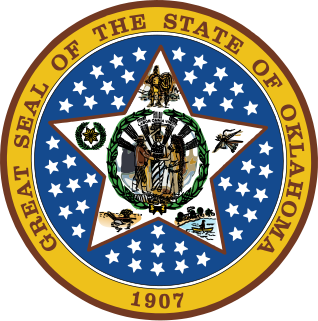Related Research Articles

The United States Department of the Interior (DOI) is one of the executive departments of the U.S. federal government headquartered at the Main Interior Building, located at 1849 C Street NW in Washington, D.C.. It is responsible for the management and conservation of most federal lands and natural resources, and the administration of programs relating to Native Americans, Alaska Natives, Native Hawaiians, territorial affairs, and insular areas of the United States, as well as programs related to historic preservation. About 75% of federal public land is managed by the department, with most of the remainder managed by the Department of Agriculture's Forest Service. The department was created on March 3, 1849.

The Federal Emergency Management Agency (FEMA) is an agency of the United States Department of Homeland Security (DHS), initially created under President Jimmy Carter by Presidential Reorganization Plan No. 3 of 1978 and implemented by two Executive Orders on April 1, 1979. The agency's primary purpose is to coordinate the response to a disaster that has occurred in the United States and that overwhelms the resources of local and state authorities. The governor of the state in which the disaster occurs must declare a state of emergency and formally request from the President that FEMA and the federal government respond to the disaster. The only exception to the state's gubernatorial declaration requirement occurs when an emergency or disaster takes place on federal property or to a federal asset—for example, the 1995 bombing of the Alfred P. Murrah Federal Building in Oklahoma City, Oklahoma, or the Space Shuttle Columbia in the 2003 return-flight disaster.

The United States Immigration and Naturalization Service (INS) was an agency of the U.S. Department of Labor from 1933 to 1940 and the U.S. Department of Justice from 1940 to 2003.

The Federal Civil Defense Authority was established in the United States Department of Defense (DOD), by DOD Directive 5105.43, May 5, 1972.
An office of emergency management (OEM), alternatively called an emergency management office (EMO), or an emergency management agency (EMA) in some areas, is an agency at the local, tribal, state, national or international level that holds responsibility for comprehensively planning for and responding to and recovering from all manner of disasters, whether man-made or natural. An OEM may also be requested to provide consequence management for large special events such as major gatherings, visiting dignitaries, etc.

The War Shipping Administration (WSA) was a World War II emergency war agency of the US government, tasked to purchase and operate the civilian shipping tonnage the United States needed for fighting the war. Both shipbuilding under the Maritime Commission and ship allocation under the WSA to Army, Navy or civilian needs were closely coordinated though Vice Admiral Emory S. Land who continued as head of the Maritime Commission while also heading the WSA.

The War Production Board (WPB) was an agency of the United States government that supervised war production during World War II. President Franklin D. Roosevelt established it in January 1942, with Executive Order 9024. The WPB replaced the Supply Priorities and Allocations Board and the Office of Production Management.

New York City Emergency Management (NYCEM) was originally formed in 1996 as part of the Mayor's Office under Rudolph W. Giuliani. By a vote of city residents in 2001 it became an independent agency, headed by the commissioner of emergency management. In 2006 the office was reorganized under the deputy mayor for administration by Mayor Michael Bloomberg.

The National Disaster Medical System (NDMS) is a federally coordinated healthcare system and partnership of the United States Departments of Health and Human Services (HHS), Homeland Security (DHS), Defense (DOD), and Veterans Affairs (VA). The purpose of the NDMS is to support State, local, Tribal and Territorial authorities following disasters and emergencies by supplementing health and medical systems and response capabilities. NDMS would also support the military and the Department of Veterans Affairs health care systems in caring for combat casualties, should requirements exceed their capacity.

The Department of Budget and Management is an executive body under the Office of the President of the Philippines. It is responsible for the sound and efficient use of government resources for national development and also as an instrument for the meeting of national socio-economic and political development goals.
The Federal Real Estate Board was a United States federal agency established in 1921 within the Treasury Department to manage federal properties, with its purpose being to reduce expenses by coordinating the use of real estate across federal agencies. It was active in the Harding and Coolidge administrations.

Office of Civilian Defense was a United States federal emergency war agency set up May 20, 1941, by Executive Order 8757 to co-ordinate state and federal measures for protection of civilians in case of war emergency. Its two branches supervised protective functions such as blackouts and special fire protection and "war service" functions such as child care, health, housing, and transportation. It also created the Civil Air Patrol. The agency was terminated by Executive Order 9562 of June 4, 1945. The Office of Civil Defense with similar duties was established later.
The Florida Division of Emergency Management (DEM) is charged with maintaining a comprehensive statewide program of emergency management. The division ensures that Florida is prepared to respond to emergencies, recover from them, and mitigate their impacts. DEM is responsible for the State Emergency Response Team (SERT) which is composed of various intergovernmental entities, volunteers, and the private sector. The division coordinates the efforts of the Federal Government with other departments and agencies of state government, with county and municipal governments and school boards, and with private agencies that have a role in emergency management. The Director is appointed by the Governor of Florida, and serves as an agency head. Kevin Guthrie currently serves as the Director. He was appointed by Governor Ron DeSantis in May 2021.
Executive Schedule is the system of salaries given to the highest-ranked appointed officials in the executive branch of the U.S. government. The president of the United States appoints individuals to these positions, most with the advice and consent of the United States Senate. They include members of the president's Cabinet, several top-ranking officials of each executive department, the directors of some of the more prominent departmental and independent agencies, and several members of the Executive Office of the President.
The Defense Production Administration (DPA) was an independent agency of the United States government for oversight and control of the defense production programs of the United States during wartime mobilization in the Korean War era.

The Oklahoma Department of Emergency Management (OEM) is a department of the government of Oklahoma responsible for coordinating the response to a natural disaster that has occurred in the State and that has overwhelmed the abilities of local authorities. This is achieved primarily through the development and maintenance of a comprehensive statewide emergency management plan. OEM is responsible for coordinating the efforts of the federal government with other state departments and agencies, county and municipal governments and school boards, and with private agencies that have a role in emergency management.

The Oklahoma Emergency Management Act of 2003 is an Oklahoma state law that replaced the Oklahoma Civil Defense and Emergency Resources Management Act of 1967 as the primary state law detailing emergency management in Oklahoma. The Emergency Management Act and the Catastrophic Health Emergency Powers Act together form the primary state laws regarding emergency and disastrous situations that may occur in the state.

The Tennessee Emergency Management Agency (TEMA) is an agency of Tennessee government tasked with preparing for and responding to natural and man-made disasters across the state of Tennessee. The agency is headquartered in Nashville, Tennessee. TEMA is a component of the Tennessee Military Department, along with the Tennessee National Guard and the Tennessee State Guard.
References
- ↑ "The Papers of (Albert) Wayne Coy". FDR Presidential Library and Museum.